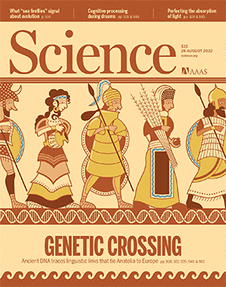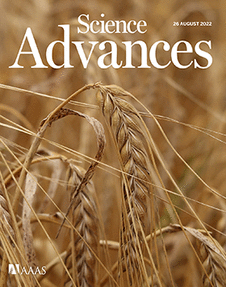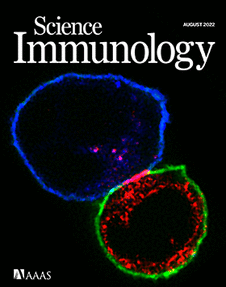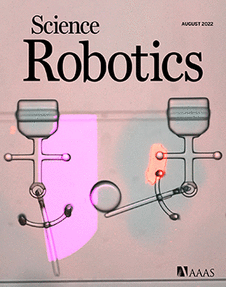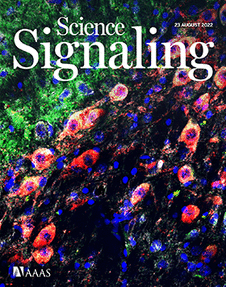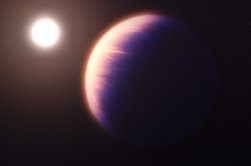Astronomers have found carbon dioxide (CO2) in the atmosphere of a Saturn-size planet 700 light-years away—the first unambiguous detection of the gas in a planet beyond the Solar System. The discovery, made by the James Webb Space Telescope, provides clues to how the planet formed. The result also shows just how quickly Webb may identify a spate of other gases, such as methane and ammonia, which could hint at a planet’s potential habitability for life.
Webb is “ushering in this new era of the atmospheric science of exoplanets,” says Nikku Madhusudhan of the University of Cambridge, who was not involved in the study.
The Webb telescope is sensitive to infrared wavelengths of light that are mostly blocked by Earth’s atmosphere. It has already dazzled astronomers with its ability to bring the universe’s most distant stars and galaxies into view.
But the infrared sensitivity is also critical for researchers studying worlds much closer to home, in the Milky Way. When an exoplanet’s orbit takes it in front of its star, some of the starlight passes through the planet’s atmosphere and carries fingerprints of its composition. The atmospheric gases absorb specific wavelengths of light, which show up as dips in brightness when the starlight is spread out into a spectrum.
For most gases of interest, the dips occur at infrared wavelengths. The Hubble Space Telescope and its infrared sibling, the Spitzer Space Telescope, have detected water vapor, methane, and carbon monoxide around a few hot, giant exoplanets, but little more.
Webb promises to reveal many more gases in smaller Neptune-size planets and potentially even rocky planets similar in size to Earth, although it is unlikely to be able to confirm the existence of life.
For its first exoplanet observations, astronomers targeted the hot gas giant WASP-39b, which orbits its star every 4 days in an orbit much tighter than Mercury’s. The first data were taken on 10 July and the team started work on them a few days later. Even in raw data based on a single transit across the star, the spectral dip of CO2 “sticks out like a sore thumb,” says Webb team member Jacob Bean of the University of Chicago. There have been some tentative detections of the gas before, he says, but none of them held up under scrutiny. Webb’s spectrum was “the right size, the right shape, and in the right position,” Bean says. “CO2 just popped out.”
Bean and his colleagues reported the results yesterday on the preprint server arXiv and they will appear in Nature in the near future.
Hubble and Spitzer have previously found water vapor, sodium, and potassium in WASP-39b’s atmosphere. Webb has now added CO2, as well as another gas whose spectral signature was initially a mystery. Later observations revealed what it is, but Bean would not say anything about it until the result is peer reviewed.
In the coming months the team will publish the planet’s full spectrum from optical to midinfrared, and “make a complete chemical inventory of its atmosphere,” says team member Laura Kreidberg of the Max Planck Institute for Astronomy.
Finding CO2 is valuable because it is a clue to a planet’s “metallicity”—the proportion of elements heavier than helium in its makeup. Hydrogen and helium produced in the big bang are the starting materials for all the visible matter in the universe, but anything heavier was forged later in stars. Researchers believe a good supply of heavy elements is crucial for creating giant planets. When planets form out of a disk of material around a new star, heavier elements form solid grains and pebbles that glom together into a solid core that eventually is massive enough to pull in gases with its own gravity and grow into a gas giant.
From the CO2 signal of WASP-39b, the team estimates the planet’s metallicity roughly matches Saturn’s. Curiously, WASP-39b is roughly the same mass as Saturn. The planets share some commonalities even though they have wildly different orbits, Bean says. “Can we find a common story for these two objects?” he says. “I don’t know yet.”
With Webb, finding “important chemicals will be the norm rather than the exception,” Madhusudhan says. He predicts that when Webb starts to study cooler planets closer in size to Earth, there will be some real surprises—perhaps some gases that could indicate whether the planets are amenable to life. “It’s anyone’s guess,” he says. “A whole zoo of chemicals is possible.”
